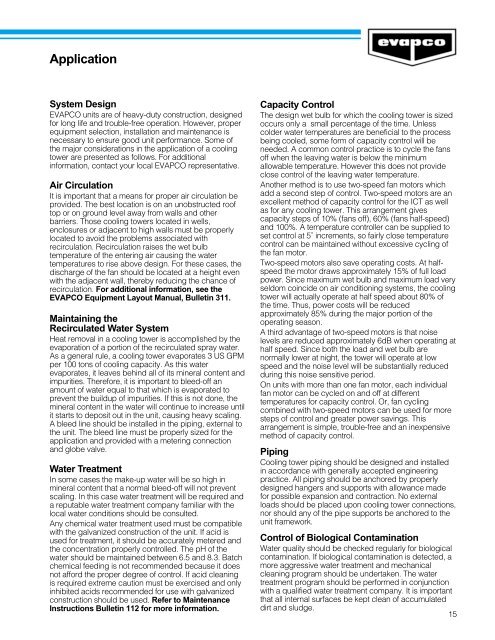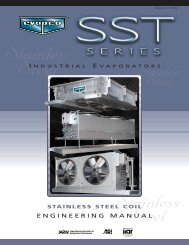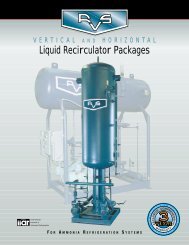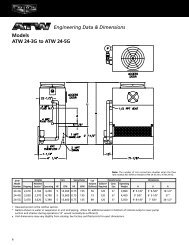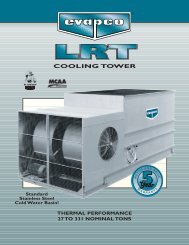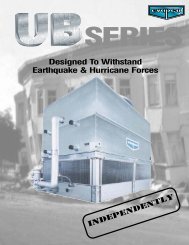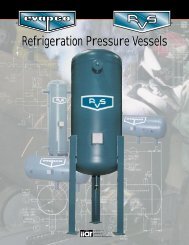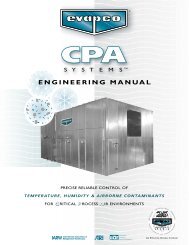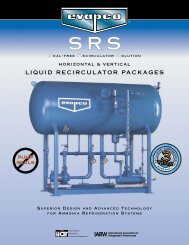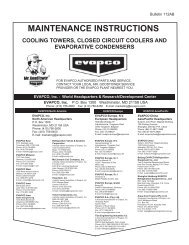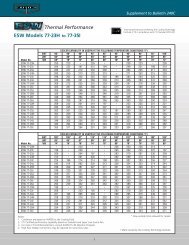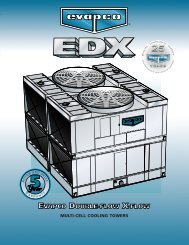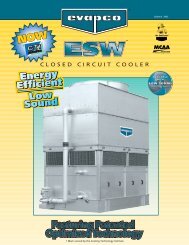ICT Cooling Towers - Evapco
ICT Cooling Towers - Evapco
ICT Cooling Towers - Evapco
Create successful ePaper yourself
Turn your PDF publications into a flip-book with our unique Google optimized e-Paper software.
Application<br />
System Design<br />
EVAPCO units are of heavy-duty construction, designed<br />
for long life and trouble-free operation. However, proper<br />
equipment selection, installation and maintenance is<br />
necessary to ensure good unit performance. Some of<br />
the major considerations in the application of a cooling<br />
tower are presented as follows. For additional<br />
information, contact your local EVAPCO representative.<br />
Air Circulation<br />
It is important that a means for proper air circulation be<br />
provided. The best location is on an unobstructed roof<br />
top or on ground level away from walls and other<br />
barriers. Those cooling towers located in wells,<br />
enclosures or adjacent to high walls must be properly<br />
located to avoid the problems associated with<br />
recirculation. Recirculation raises the wet bulb<br />
temperature of the entering air causing the water<br />
temperatures to rise above design. For these cases, the<br />
discharge of the fan should be located at a height even<br />
with the adjacent wall, thereby reducing the chance of<br />
recirculation. For additional information, see the<br />
EVAPCO Equipment Layout Manual, Bulletin 311.<br />
Maintaining the<br />
Recirculated Water System<br />
Heat removal in a cooling tower is accomplished by the<br />
evaporation of a portion of the recirculated spray water.<br />
As a general rule, a cooling tower evaporates 3 US GPM<br />
per 100 tons of cooling capacity. As this water<br />
evaporates, it leaves behind all of its mineral content and<br />
impurities. Therefore, it is important to bleed-off an<br />
amount of water equal to that which is evaporated to<br />
prevent the buildup of impurities. If this is not done, the<br />
mineral content in the water will continue to increase until<br />
it starts to deposit out in the unit, causing heavy scaling.<br />
A bleed line should be installed in the piping, external to<br />
the unit. The bleed line must be properly sized for the<br />
application and provided with a metering connection<br />
and globe valve.<br />
Water Treatment<br />
In some cases the make-up water will be so high in<br />
mineral content that a normal bleed-off will not prevent<br />
scaling. In this case water treatment will be required and<br />
a reputable water treatment company familiar with the<br />
local water conditions should be consulted.<br />
Any chemical water treatment used must be compatible<br />
with the galvanized construction of the unit. If acid is<br />
used for treatment, it should be accurately metered and<br />
the concentration properly controlled. The pH of the<br />
water should be maintained between 6.5 and 8.3. Batch<br />
chemical feeding is not recommended because it does<br />
not afford the proper degree of control. If acid cleaning<br />
is required extreme caution must be exercised and only<br />
inhibited acids recommended for use with galvanized<br />
construction should be used. Refer to Maintenance<br />
Instructions Bulletin 112 for more information.<br />
Capacity Control<br />
The design wet bulb for which the cooling tower is sized<br />
occurs only a small percentage of the time. Unless<br />
colder water temperatures are beneficial to the process<br />
being cooled, some form of capacity control will be<br />
needed. A common control practice is to cycle the fans<br />
off when the leaving water is below the minimum<br />
allowable temperature. However this does not provide<br />
close control of the leaving water temperature.<br />
Another method is to use two-speed fan motors which<br />
add a second step of control. Two-speed motors are an<br />
excellent method of capacity control for the <strong>ICT</strong> as well<br />
as for any cooling tower. This arrangement gives<br />
capacity steps of 10% (fans off), 60% (fans half-speed)<br />
and 100%. A temperature controller can be supplied to<br />
set control at 5˚ increments, so fairly close temperature<br />
control can be maintained without excessive cycling of<br />
the fan motor.<br />
Two-speed motors also save operating costs. At halfspeed<br />
the motor draws approximately 15% of full load<br />
power. Since maximum wet bulb and maximum load very<br />
seldom coincide on air conditioning systems, the cooling<br />
tower will actually operate at half speed about 80% of<br />
the time. Thus, power costs will be reduced<br />
approximately 85% during the major portion of the<br />
operating season.<br />
A third advantage of two-speed motors is that noise<br />
levels are reduced approximately 6dB when operating at<br />
half speed. Since both the load and wet bulb are<br />
normally lower at night, the tower will operate at low<br />
speed and the noise level will be substantially reduced<br />
during this noise sensitive period.<br />
On units with more than one fan motor, each individual<br />
fan motor can be cycled on and off at different<br />
temperatures for capacity control. Or, fan cycling<br />
combined with two-speed motors can be used for more<br />
steps of control and greater power savings. This<br />
arrangement is simple, trouble-free and an inexpensive<br />
method of capacity control.<br />
Piping<br />
<strong>Cooling</strong> tower piping should be designed and installed<br />
in accordance with generally accepted engineering<br />
practice. All piping should be anchored by properly<br />
designed hangers and supports with allowance made<br />
for possible expansion and contraction. No external<br />
loads should be placed upon cooling tower connections,<br />
nor should any of the pipe supports be anchored to the<br />
unit framework.<br />
Control of Biological Contamination<br />
Water quality should be checked regularly for biological<br />
contamination. If biological contamination is detected, a<br />
more aggressive water treatment and mechanical<br />
cleaning program should be undertaken. The water<br />
treatment program should be performed in conjunction<br />
with a qualified water treatment company. It is important<br />
that all internal surfaces be kept clean of accumulated<br />
dirt and sludge.<br />
15


